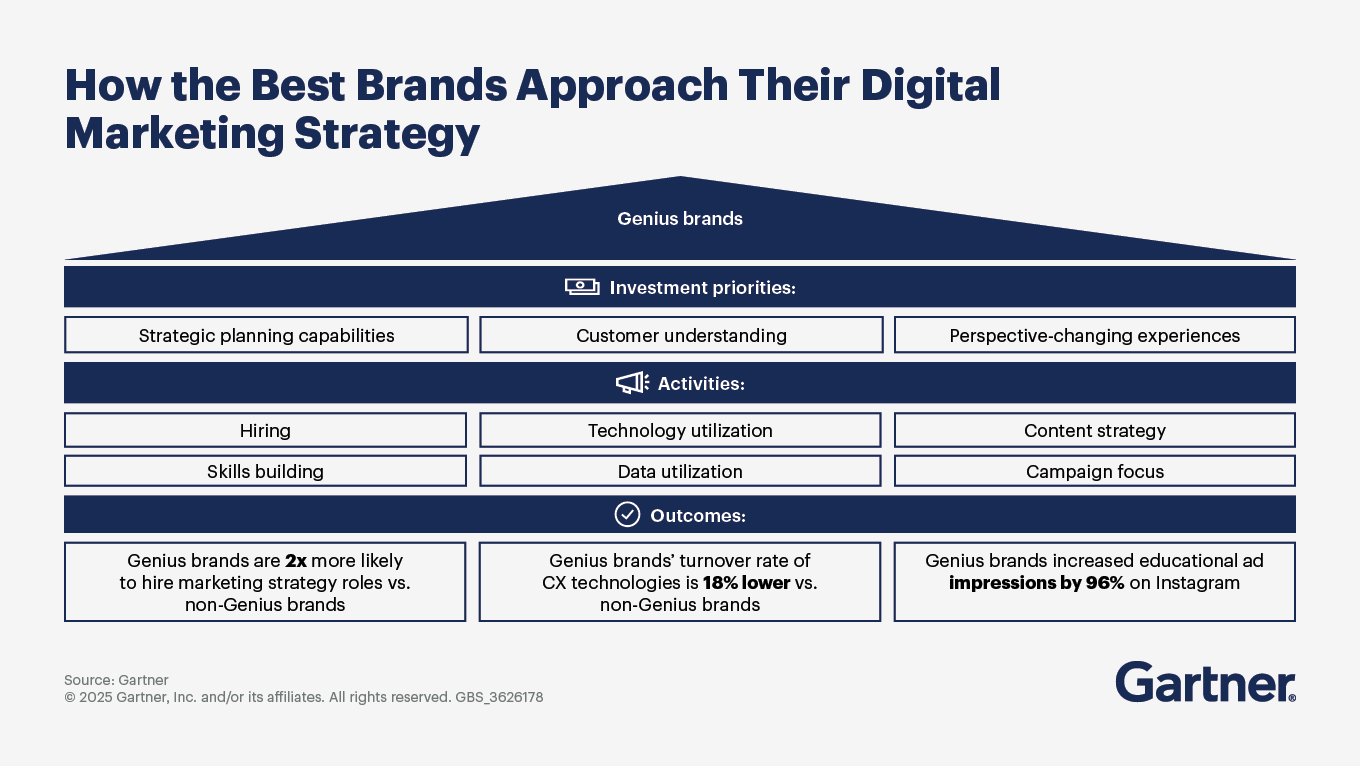The right digital marketing process helps attract, convert and retain your most valuable customers — across every channel.
- Gartner client? Log in for personalized search results.
What sets top digital marketing strategies apart
An effective digital marketing strategy isn’t just a blueprint — it’s a dynamic system that builds customer relationships, navigates constant change and ultimately drives growth. Whether you’re scaling what works or overhauling what doesn’t, success starts with a strategy rooted in clarity, adaptability and measurable outcomes. A high-performing digital marketing strategy is grounded in proven practices and designed to evolve with changing customer behaviors, technologies and business goals.
Jump to what matters most to you:
See Gartner research in action at our marketing conferences and events.
5 key drivers of a high-impact digital marketing strategy
These essential components of a successful marketing strategy enable brands to expand their reach and engagement.
1. Strategy: Clarify your goals across digital experiences, channels and campaigns
Top brands continually refine their digital presence and integrate physical and digital experiences. They also adopt emerging technologies to stay ahead.
The most effective strategies translate broad goals into actionable items. While every organization’s approach will look different, the most successful digital marketing strategies share a set of foundational elements:
A clear vision for how digital marketing drives enterprise growth. For example, boosting profit might mean increasing customer lifetime value (CLV) through stronger engagement or upselling.
Defined roles and responsibilities across the marketing team. Digital marketing leaders, for example, oversee marketing budgets, hiring, martech selection and campaign planning.
A performance roadmap that connects short-term priorities with long-term outcomes. These could include improving lead quality, increasing brand awareness or accelerating sales.
A skills and tools assessment. Ensure this includes a plan to close gaps that could prevent successful execution.
2. Channel management: Align the best channel with your target audiences and specific goals
A strong digital marketing strategy delivers personalized, meaningful engagement — across the full funnel and every channel. To make the most of digital channels and respond to shifting behaviors, marketers must plan, execute and measure efforts holistically.
To reach increasingly fragmented audiences, make the most of digital channels and respond to shifting behaviors, orchestrate campaigns across multiple touchpoints — without losing message clarity or brand cohesion. That starts with understanding how multichannel marketing functions as both a foundation and amplifier for digital engagement across key touchpoints such as:
Websites
Paid and organic social media
Search and display ads
TV and OTT streaming
Digital video
Email and mobile marketing (SMS, push notifications, in-app messaging and messaging apps)
Voice-enabled devices (e.g., smart speakers and smartphone-based virtual assistants)
But showing up across multiple channels isn’t enough. Customers expect each interaction to feel relevant to their needs, interests and behaviors — with caveats. Eighty-six percent of them welcome some personalized communication, but 55% will stop engaging if it feels invasive and another 40% will walk away if it feels irrelevant.
Yet nearly two-thirds of marketers struggle to consistently deliver personalized customer experiences thanks to fragmented privacy laws, platform proliferation, shifting consumer expectations, declining ROI and conversion, and pressure to show results faster.
To meet these challenges, focus on:
Linking personalization tactics to business goals
Prioritizing actions based on impact, feasibility and audience insight
Evaluating technology based on outcomes, not just features
3. Advertising: Beat challenges, assess new channels and deliver clear digital marketing results
A successful digital marketing strategy includes a smart, flexible approach to advertising across display, video, mobile and social. Paid search plays a critical role by matching ad content to a user’s real-time search intent.
But during times of disruption — think: economic shifts, evolving customer behaviors, the ad tech landscape and AI-enabled behavior — advertising budgets often face early scrutiny. Chief marketing officers (CMOs) are under pressure to justify spend and prove return, especially when advertising claims a large share of the budget.
Digital marketing leaders must be ready to rethink media and marketing mix, reframe ad messaging and stay a step ahead of the competition. To strengthen the advertising portion of a digital marketing strategy:
Take calculated risks. Instead of defaulting to spend cuts — or clinging to business as usual — build scenario plans. Use them to explore how budget decisions play out under different economic and market conditions, and lean into cost optimization.
Refocus your publisher mix. Shift spend toward high-impact bets. Cut back on indirect, always-on placements and invest in core campaigns through direct buys that align with your strategy.
Extend video ad ROI. Repurpose creative across platforms, formats and devices. Slice and adapt your best-performing video content to stretch value and expand reach.
4. Privacy: Tackle the challenge of leveraging and protecting customer data
Customer data is at the heart of any digital marketing strategy, but collecting, managing and activating it has never been more complex. And contrary to expectations, more data doesn’t always mean better analytics.
In fact, 57% of organizations with connected data sources say marketing analytics still hasn’t had the expected impact on decision making. As the focus shifts to owned channels and first-party data, digital marketing leaders must identify value-driving opportunities — and navigate the roadblocks that come with change.
The strength of a digital marketing strategy lies in relevance. That means understanding customer behavior, anticipating needs and tailoring experiences accordingly.
But new regulations, cookie deprecation and stricter data usage standards have transformed how data is collected, stored and activated. Amidst limited access to quality first-party data, declining trust in third-party data, and more, brands must rethink how they buy, target and measure digital ads.
To succeed, marketers need a strong data and analytics foundation, the right technology investments and compelling, consent-based touchpoints for first-party data collection. This enables you to:
Stay ahead of privacy changes
Double down on first-party data
Ensure enterprisewide compliance
Test privacy-safe targeting
Put customers in control
5. Performance benchmarks: Improve your ability to assess marketing’s impact
A strong digital marketing strategy relies on using the right metrics to measure what matters. But according to the Gartner Multichannel Marketing Survey, 80% of digital marketing leaders struggle to define a consistent set of metrics and methods for measuring multichannel impact. Top challenges include misaligned KPIs, difficulty gaining internal consensus and siloed measurement approaches.
Still, organizations that use a more integrated approach to performance measurement see better results. Eighty-six percent of teams using a siloed approach struggle to define common metrics; only 67% of those using a holistic model across all channels have this problem.
Your digital marketing strategy doesn’t need dozens of metrics — just the right ones, tied to outcomes that matter. The most-used metric categories include:
Transactional: sales, revenue, conversion rates
Competitive: market share, voice share, wallet share
Engagement: social interactions, email open rates, click-throughs
Perceptual: customer satisfaction, Net Promoter Score, customer effort
Pipeline: lead quality, time to close, cost per lead, win rate
Relationship: customer lifetime value (CLV), LTV:CAC ratio
Awareness: aided and unaided awareness, earned reach
Digital marketing strategy FAQs
What is a digital marketing strategy?
There is no single digital marketing strategy framework, but key components of any digital marketing strategy include a vision; a clearly scoped and defined set of responsibilities for the digital marketing team and leadership; a detailed roadmap that lays out near-term digital marketing program objectives; and an assessment of team skills, tools and processes needed to support digital marketing objectives.
Why have a digital marketing strategy?
Digital is no longer just a means of enhancing customer relationships; it’s a primary medium for building new connections with target audiences, whether that’s employees, business partners or social influencers. A digital marketing strategy enables brands to scale reach and engagement across websites, social media and digital advertising to target, acquire and retain customers.
How do I align digital marketing with business goals?
Align digital marketing with business goals by clearly defining objectives and integrating them into the marketing strategy. Ensure marketing activities support business growth, such as increasing brand awareness or boosting sales. Regularly review and adjust strategies to respond to market changes and customer needs, maintaining alignment with overarching business objectives.
Attend a Conference
Join Gartner experts and your peers to accelerate growth
Join CMOs and marketing executives to learn how to navigate emerging trends and challenges. From peer-led sessions to analyst one-on-ones, you'll leave ready to tackle your mission-critical priorities.
Gartner Marketing Symposium/Xpo™
Denver, CO

Drive stronger performance on your mission-critical priorities.
